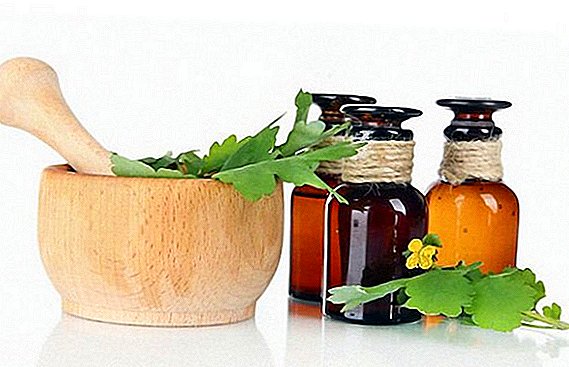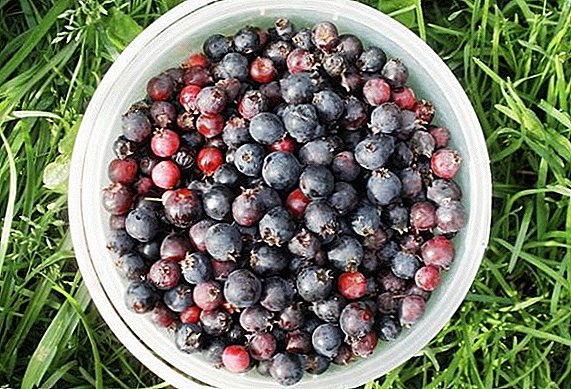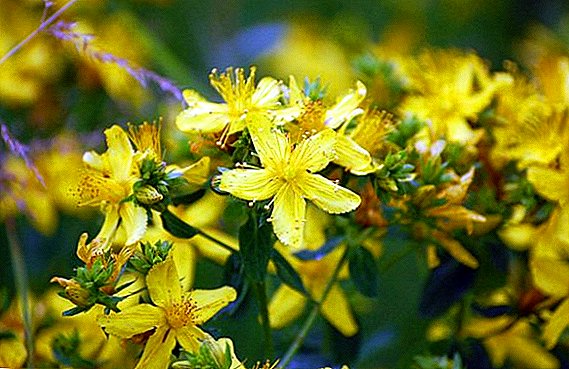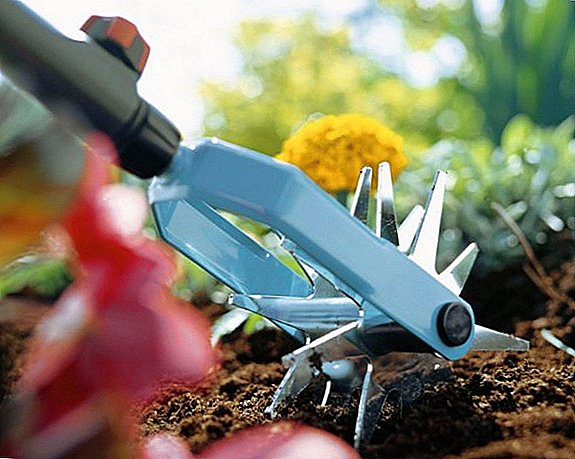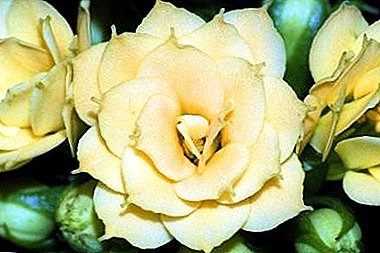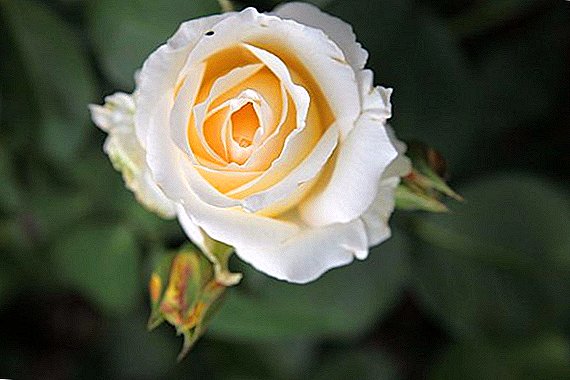 Roses are popular with experienced gardeners and amateurs. And this is not at all surprising - the lush bush with fragrant flowers is known to everyone, it organically looks both indoors and in the garden, is simple in maintenance, but not boring.
Roses are popular with experienced gardeners and amateurs. And this is not at all surprising - the lush bush with fragrant flowers is known to everyone, it organically looks both indoors and in the garden, is simple in maintenance, but not boring.
Speaking of pink flowers, you should pay attention to such a variety as the rose "Chopin." Its features, methods of reproduction and the rules of successful cultivation, we consider in this article.
Polish variety description
Rose "Chopin" refers to the type of hybrid tea, a feature which can be considered not only the high quality of flowers and their decorative use, but also the so-called "undulating flowering", in several approaches.  Description of roses "Chopin" should begin, first of all, with very large white flowers with high frost resistance and long flowering. The variety itself is rather young - it was bred in Poland only in 1990.
Description of roses "Chopin" should begin, first of all, with very large white flowers with high frost resistance and long flowering. The variety itself is rather young - it was bred in Poland only in 1990.
It is considered a successful compromise between the beauty of the plant and ease of care. The buds open rather slowly and do not fall off for at least two weeks. Flowers are always white or milky.
Each type of roses - Floribunda, English, Canadian, wrinkled, ground cover, climbing, bush, standard - can take a worthy place in your garden.The variety of roses "Chopin" is resistant to cold - it is assigned the sixth zone of frost resistance, which means the plant's ability to tolerate cold down to -18 ... -23 ° С. In addition, this variety has an average resistance to diseases and parasites.
But the rains of the plants are not very fond of - the inflorescences can be damaged by drops, and when water stagnates in the soil, the stems and root system can rot. 
Rose bushes
The shrub of this variety is the same as that of other plants of the tea-hybrid species - large green leaves, thick shoots with large bright spikes. The bush itself is big enough. On average, the height of the adult plant reaches 120-140 cm, and in diameter - about 80 cm.
Important!Growing "Chopin" quickly enough, so it is great for quick planting site. One year after the planting, a full-blooming shrub grows.It is worth noting that the branches of the bush grow chaotically, the plant loses its shape. So to maintain the presentation of trimming is to be engaged throughout the entire period of the life of the bush.
Flowers
Like all hybrid tea roses, Chopin is a re-flowering variety. This means that the bloom is undulating, after the first batch of flowers has blossomed, buds appear for the next.
On one stalk 1-3 flowers with a thin, not sharp aroma. The flowers of this variety are cream, darker towards the middle of the bud and white to the edge of the petal. Roses "Chopin" are always bright and always with large inflorescences - 12-13 cm in diameter. Petals terry with wavy edge. Buds open slowly, allowing the plant to bloom for a long time. The bud does not fall off, and the smell does not disappear for 1-2 weeks even after cutting the flower. In the bud, as a rule, 30-40 petals.
Roses "Chopin" are always bright and always with large inflorescences - 12-13 cm in diameter. Petals terry with wavy edge. Buds open slowly, allowing the plant to bloom for a long time. The bud does not fall off, and the smell does not disappear for 1-2 weeks even after cutting the flower. In the bud, as a rule, 30-40 petals.
Where to plant a rose?
Since the bush "Chopin" is considered vigorous, he definitely needs space. As you know, the diameter of the bush is usually 80 cm, and the height is more than a meter, which already indicates the scale of the future plant. In addition, this variety has a powerful root system - up to half a meter deep.
On this basis, the plant will prefer planting on the site or in the greenhouse, but not indoors. For the cultivation of roses in the office or at home, it is better to look at the flowers such as patio or miniature roses. Their height varies between 25-50 cm, depending on the variety, they love warmth and live well in pots.
Did you know?Rose oil is more expensive than platinum and gold. The reason for this is a high flow rate to obtain an oily liquid. Thus, to obtain 100 g of oil, 300 kg of petals must be processed.In addition, "Chopin" is picky about lighting and soil, does not tolerate drafts and flooding the soil. Choose a well-lit area, closed to the winds. Take care of proper soil and good drainage.
 In early spring, during the period of melting snow, it is worthwhile to increase the drainage cover or to make drains to avoid rotting of the stems. The beginning of May is considered to be the ideal time for planting: the heat, the heated soil, there are no frosts and rains, but there is still no scorching sun. Option autumn planting - from mid-September to mid-October.
In early spring, during the period of melting snow, it is worthwhile to increase the drainage cover or to make drains to avoid rotting of the stems. The beginning of May is considered to be the ideal time for planting: the heat, the heated soil, there are no frosts and rains, but there is still no scorching sun. Option autumn planting - from mid-September to mid-October.Lighting and location
Roses love light, and for Chopin, lighting is one of the most important criteria. Direct rays or diffused light is not so important, the main thing is its abundance and sufficient heat. Do not recommend planting roses in the lowlands, as the accumulation of excess moisture can badly affect the stems.
Forming the rose garden one should consider different combinations of varieties - Abraham Derby, Mary Rose, Graham Thomas, William Shakespeare, Blue Perfume, Pink Intuition, Falstaff, Sophia Loren, Pierre de Ronsard.
Soil requirements
Roses to the soil are demanding, so this question is quite important. Do not plant seedlings in unprepared land. First, because of the powerful fast-growing root system, it is necessary to dig up the soil beforehand, facilitating the growth of young roots. Secondly, few plants like stagnant water. Therefore, at the bottom of the hole for planting you need to put a layer of drainage.
As for the quality of the soil itself, it should be loose, loamy, with a small amount of humus. Sand can be used to loosen the soil. Creating ideal conditions for the sprout, mix sand, fertile land, manure, peat and special pink mineral fertilizer (ratio 2: 2: 3: 1 and fertilizer according to the instructions), and plant the plant in this mixture.
Creating ideal conditions for the sprout, mix sand, fertile land, manure, peat and special pink mineral fertilizer (ratio 2: 2: 3: 1 and fertilizer according to the instructions), and plant the plant in this mixture.
Planting rules seedlings
As stated, there are spring (May) and autumn (September-October) periods of planting roses. However, before the process of planting is worth some preparatory work.
- Sprout preparation.
 If your plant is already with sprouts, then you can hold it until planting in the snow outside (in winter) or in a pot on the balcony (in winter and summer). Plant a rose in a large jar and, without closing the lid, put it on the balcony. Note that the plant will need to be sprayed daily in order to avoid the spider mite on it.
If your plant is already with sprouts, then you can hold it until planting in the snow outside (in winter) or in a pot on the balcony (in winter and summer). Plant a rose in a large jar and, without closing the lid, put it on the balcony. Note that the plant will need to be sprayed daily in order to avoid the spider mite on it.In the cold season, plant the seedling in the peat mixture in the box, close it. Put the box in the bag so that all sides except the top cover are covered from moisture. Zarytoy seedling in a snowdrift, covering the top with branches. So the plant can lie in the heat before the first thaw.
Before the process of planting soak the sprout in water for 6-8 hours. After the root system is finished, the roots should be cut, leaving 25-30 cm from the base. Shoots also need to be cut, leaving no more than 3-4 on a bush. Old stems shorten a little, leaving a couple of eyes.
- Preparation of the landing pit.
The main thing when placing the plant in the planting hole - carefully place the roots, directing them down and to the sides, without creases, damage and curvatures. As you land, gradually fill the ground, tamping it down and watering it. The plant should stand firmly in the ground, not fall and not swing.
Important! The root collar needs to be deepened into the soil, but not more than 2-3 cm. Leaving it outside or too sprinkled with earth, the plant can regenerate without starting to bloom.Immediately after planting, the sprout is best applied to allow the plant to take root. Gradually, the shadow must be removed. Also immediately after planting, gardeners recommend planting a pile, regardless of the season. After the flower starts to grow, the plant needs to be unlocked.

Breeding methods
Rose "Chopin" can be propagated by dividing and grafting.
- Reproduction by division: dig out an old bush and carefully divide it into two identical parts. Plant in the prepared soil in the same way as a young seedling.
- Propagation by grafting: gently cut a developed shoot at an angle of 45 ° just above the kidney. The workpiece should be about 15 cm in length. Please note that it is best to use the rose of the current year for planting. Tear off the leaves at the bottom of the cutting and deepen it into loose earth by 8-10 cm. Cover the seedling with a transparent material, place it in a sunny corner. The temperature for storing the cutting is + 15 ... +17 ° С.
Another way to get a strong and sustainable plant is by grafting a rose.Blossom roses grown from cuttings begin in a year, while those propagated by division can start blooming much earlier. Planting seedlings is also necessary - in early May or late September.

How to care for a grade?
Roses "Chopin" are cold-resistant and not quite capricious as for hybrid tea flowers. However, these royal colors have their own nuances of care. First of all, you should carefully care for the plant in its first year of life.
If you want to get a rich flowering bush, it is better to pick young buds and not let it bloom until August (for May plants). Flowering when ripe depletes the flower, which may affect its further beauty.
Since August, the plant can begin to bloom - at this age, the plant is strong enough to maintain a presentable appearance.
How to water?
The "Chopin" shrubs require regular watering regardless of the season. Watering should be evenly, and not just paying attention to the roots. As soon as the top layer dries out, it is necessary to water the plant again.
It is the top layer that is an indicator of soil moisture, if it has been properly prepared. On a young plant usually takes 5-10 liters, for an adult - 15-20 liters for watering. Before watering the plant, loosen the soil without damaging the roots, remove the weeds.
Plant nutrition
Roses need to be fed 3-4 times per season, not counting the mineral fertilizer during planting. Before the buds began to form, you need to feed with nitrogen fertilizer. After the beginning of flowering potassium phosphate composition is used. You can also use specialized pink fertilizer according to the instructions.
In any case, the fertilizer is applied to the soil only after it has been watered. In order to pour the mixture into the ground, you need to make a circular groove around the stem at a distance of 30-40 cm and pour fertilizer into it.
In the spring, you can spray the plant with sodium humate 0.01%. This fertilizer is absorbed by the flower of the flower and increases the susceptibility of the plant to nitrogen, enhancing the effect of spring planned fertilizing. And when the buds begin to appear, you can fertilize the plant with succinic acid - it stimulates the growth of the bush and its abundant flowering.
Did you know? The oldest living rose grows by the wall of the cathedral in Hildesheim, Germany, and is called the Millennium Rose Garden. The age of the shrub is not exactly known, but according to legends, it is at least 1000 years old.
 As soon as flowering stops, it is necessary to stop all types of dressings. Now the plant is preparing for winter.
As soon as flowering stops, it is necessary to stop all types of dressings. Now the plant is preparing for winter.Trimming features
For the first time, the rose-first year is cut only in late autumn - the shoots are cut off above 40-50 cm and covered for wintering.
Two-year-old rose bushes are pruned three times a year: in spring, summer and winter. In the spring you need to remove dead shoots that have not suffered wintering. On the remaining branches leave 3-4 buds, as when planting plants. In the summer, pruning bears a purely decorative character - the shape of the shrub is formed, it is possible to thin out the branches and remove the flowering stems. When summer pruning also need to remove the branches that grow inside the bush and do not give buds. Winter pruning is the same as in the first year.
To cut off the shoots is only above the kidney, at an angle and always very sharp scissors or shears. A blunt cutting tool will ruin the stem and can be a source of infection.
Shelter for the winter
One of the features of roses "Chopin" - frost resistance, the sixth zone. However, these flowers also require some preparation before winter.
After the excess shoots have been cut, it is necessary to remove all the leaves and pile up the earth with humus. The height of the slide should be sufficient - up to 40 cm. Then the pile should be warmed with spandex or spunbond. Leave the lower edge of the insulation free until the onset of cold weather.
As soon as outside the temperature dropped below 0 ° C, seal the bottom of the insulation tightly, crushing it into the ground. In severe frosts, you can insulate the rose by covering it with snow.
When spring comes, the shelter should remain until the snow is completely gone. As soon as it comes, remove the insulation and raskuchivayte shrub, dig up the root neck, remove from it the stuck ground. 
Diseases and pests
With a general capriciousness of roses, it is the Chopin variety that is sufficiently resistant to such diseases as black spot and powdery mildew. However, if high humidity is observed for a long time, it is better to treat the plant prophylactically with copper preparations such as "HOM", "Oxyh", "Prognosis", "Fundazole", etc.
The most dangerous diseases for the plant are rust (yellow spots appear on the plant) and gray rot (stalks rot). In order to eliminate these diseases, the plant is sprayed with copper sulphate or Bordeaux liquid.
As for the parasites, the rose "Chopin" may suffer from such insects:
Spider mite
- Symptoms: white "cobweb" on the leaves.
- Treatment: Alatar, Intavir, Sunmite.
 Rosan sawfly.
Rosan sawfly.- Symptoms: one leaf remains from the leaf.
- Treatment: "Intavir", "Aktara".
- Prevention: plant next to marigolds, calendula or nasturtium - these smells scare away sawflies.
 Green aphid.
Green aphid.- Symptoms: green eggs and small insects on the back of the leaf and on the stems.
- Treatment: wash with water and soap, cleaning insects, and treat with "Aktellik" or "Commander".
 Thrips.
Thrips.- Symptoms: sheets with gray spots and black edges.
- Treatment: "Vertimek", "Confidor", "Fitoverm".
 Any description of roses "Chopin" will be insufficient, because these flowers are much more beautiful alive. By the way, landscape designers also liked this plant and are actively used to decorate a wide variety of gardens.
Any description of roses "Chopin" will be insufficient, because these flowers are much more beautiful alive. By the way, landscape designers also liked this plant and are actively used to decorate a wide variety of gardens.Designers offer to create from "Chopin" compositions in bright colors, planting next to flowers of pink and beige shades, combine with two-color varieties like "Nostalgie", or create contrasting rose gardens with burgundy and black colors like French roses Black Baccara.


